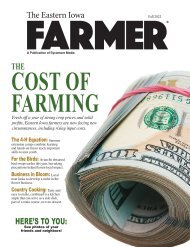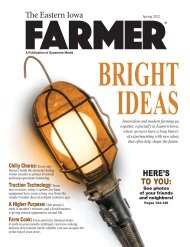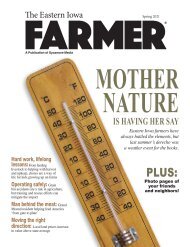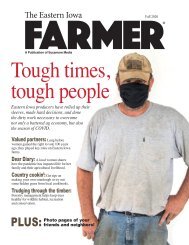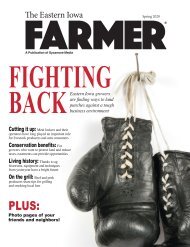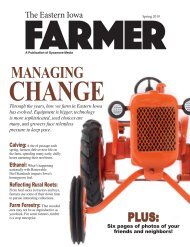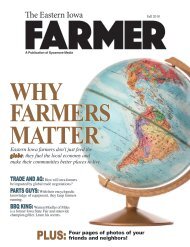You also want an ePaper? Increase the reach of your titles
YUMPU automatically turns print PDFs into web optimized ePapers that Google loves.
Ag Bytes<br />
What makes a quality<br />
carbon credit?<br />
Alejandro Plastina, ISU extension<br />
economist and associate professor,<br />
answers four questions that are key for<br />
buyers when determining the quality<br />
(and the price they are willing to pay)<br />
for carbon credits. Additional practices,<br />
permanence, verified protocols, and<br />
registered credits are all factors that play<br />
into the perceived quality of a carbon<br />
credit.<br />
Buyers often look for high-quality credits<br />
that are based on additional practices,<br />
ensure some amount of permanence, are<br />
verified, and registered, Plastina said.<br />
A carbon credit is a term for the<br />
certificate or token<br />
showing that<br />
one metric ton of<br />
carbon dioxide<br />
(or the equivalent<br />
amount of other<br />
greenhouse<br />
gases) have<br />
been reduced or<br />
sequestered, he<br />
said. But not all<br />
carbon credits are<br />
the same, nor do<br />
they hold the same<br />
value for buyers.<br />
There are a few<br />
Alejandro Plastina, key terms that<br />
ISU Extension<br />
speak to what buyers<br />
of carbon<br />
economist and<br />
associate professor credits are looking<br />
for:<br />
Are the credits from additional<br />
practices? Buyers are seeking<br />
credits created because a producer<br />
is participating in a carbon program.<br />
The carbon sequestered should<br />
be additional when compared to the<br />
carbon sequestered during “business as<br />
usual” on the same land – the practice<br />
changes would not have happened without<br />
the carbon credit incentive.<br />
Are the credits permanent? For<br />
agricultural carbon credits, there’s<br />
always concern that the practices that<br />
sequestered soil carbon in the first place<br />
can be quickly overturned. Carbon could<br />
be released back into the atmosphere<br />
from plowing soil that was in no-till<br />
production or cutting down stands of<br />
trees. Most carbon programs will specify<br />
in their contracts how long producers or<br />
land managers are obligated to maintain<br />
specific conservation practices to prevent<br />
carbon from being released back into the<br />
atmosphere.<br />
Does the carbon program use<br />
verified protocols? Verification is the<br />
process through which the reported<br />
measurements from a carbon program<br />
are evaluated to make sure they are<br />
accurate and use the specified protocols.<br />
Some carbon programs conduct their<br />
own verification, which is often viewed as<br />
less rigorous compared to working with a<br />
third-party verifier. Buyers often perceive<br />
carbon credits to be of higher quality when<br />
issued by a program that uses third-party<br />
verification.<br />
Are the credits registered? Carbon<br />
registries serve as the record-keepers for<br />
carbon markets. A registry issues a specific<br />
serial number for a specific carbon<br />
credit, and retires that serial number when<br />
the credit is sold to a buyer. A few of the<br />
primary registries worldwide include Gold<br />
Standard, Verra, American Carbon Registry,<br />
and Climate Action Reserve.<br />
For more information about the structure<br />
of carbon programs, viewi Plastina’s<br />
resources from Ag Decision Maker, “How<br />
Do Data and Payments Flow Through Ag<br />
Carbon Programs?” and “How to Grow<br />
and Sell Carbon in US Agriculture.”<br />
Hotline offers help for stress,<br />
legal questions and more<br />
The Iowa Concern Hotline number is<br />
800-447-1985. Iowa Concern is a program<br />
of the Iowa State University Extension<br />
service. The program began in 1985 as<br />
a toll-free number serving the agriculture<br />
community.<br />
Today, the toll-free number serves urban<br />
as well as rural Iowa. By calling Iowa<br />
Concern has one access to an attorney for<br />
legal education, stress counselors, and information<br />
and referral services for a wide<br />
variety of topics.<br />
In addition, Iowa Concern maintains a<br />
website, extension.iastate.edu/iowaconcern,<br />
featuring an extensive frequently<br />
asked questions database for legal, finance,<br />
crisis and disaster, and personal<br />
health issue.<br />
The website is also the link to Iowa Concern’s<br />
“Click here to chat with an Agent”<br />
service.<br />
Live chat immediately connects you with<br />
a stress counselor where you can “talk”<br />
(type) one-on-one in a secure environment.<br />
All Iowa Concern services are available<br />
24 hours a day, seven days a week at no<br />
charge.<br />
Use safety checklist when<br />
handling grain equipment<br />
Hazards abound when handling grain,<br />
such as equipment entanglement, grain<br />
entrapment and engulfment and dust<br />
explosions, among others.<br />
To lower your risk of injury:<br />
n Check that all exposed moving<br />
machinery parts have guards, shields or<br />
cages installed and are in good condition<br />
to prevent entanglement, including auger<br />
flighting, conveyers, belts and powertake-off<br />
(PTO) components.<br />
n Don’t wear loose or baggy clothing,<br />
tie back hair and remove dangling drawstrings<br />
and jewelry that could get pulled<br />
into moving parts.<br />
n Lock-out the power to augers, conveyers,<br />
belts and PTO components before<br />
performing maintenance or replacing<br />
parts so they can’t be accidentally turned<br />
on.<br />
n Stay clear of flowing grain, which can<br />
trap a person knee-deep in a few seconds<br />
and can completely submerge them<br />
in less than 20 seconds.<br />
n Work from outside of the bin whenever<br />
possible and use the buddy system<br />
and safe bin entry procedures when a bin<br />
must be entered.<br />
n Check that everyone knows how to<br />
de-energize grain loading and unloading<br />
equipment and lock-out the power sources<br />
so that grain moving equipment can’t<br />
be turned on while someone is inside of<br />
a bin.<br />
n Use hazard signage and teach kids<br />
and unexperienced people to stay out<br />
of stored grain, including bins, piles and<br />
grain transport vehicles.<br />
n Keep the grain vacuum nozzle away<br />
from the area below your feet and keep<br />
an eye on the angle of the grain surface<br />
as you are removing grain. To prevent<br />
grain flow, the grain angle should be less<br />
than the grain’s angle of repose, which<br />
is around 21 degrees for corn and 23<br />
degrees for soybeans.<br />
86 EASTERN IOWA FARMER | FALL 2023 eifarmer.com<br />
<strong>Eastern</strong>Iowa<strong>Farmer</strong>_South_Fall2023.indd 86<br />
9/19/23 3:35 PM







